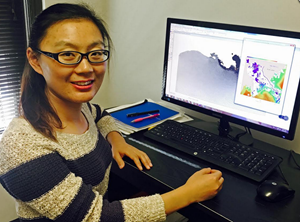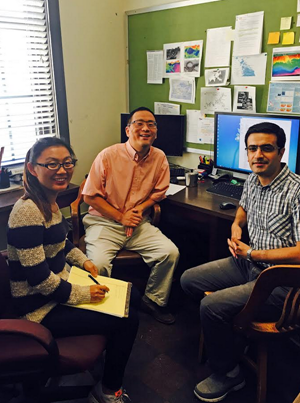
Linlin creates a movie of the Lagrangian particle tracking to determine the impacts of Davis Pond diversion on salinity gradients in the Barataria Bay. (Provided by Linlin Cui)
When oil from the Deepwater Horizon spill began approaching land, one proposed response was to divert Mississippi River water and sediment into the marshes to try and push surface oil more towards the Louisiana-Texas shelf. Linlin Cui is investigating the impacts of Mississippi River diversions on Barataria Bay hydrodynamics to help inform how future oil spill responders plan and execute freshwater diversions. Her research and its products provide tools for combating the loss of Louisiana’s coastal wetlands and for conserving and restoring healthy and productive ecosystems.
Linlin is a Ph.D. student in Louisiana State University’s (LSU) Oceanography and Coastal Sciences program and a GoMRI Scholar with CWC.
Her Path

Linlin (left), Haosheng Huang (center), and Soroush Sorourian (right) discuss the research process in Huang’s office. (Provided by Linlin Cui)
Linlin grew up in a small fishing town near China’s Yellow Sea. Her childhood included fond memories of tasting new types of seafood and of fishermen selling fresh catches at the local seafood market. Most of China’s eastern coastal areas, including Linlin’s hometown, experienced rapid economic growth since the early 2000s. Booms in the manufacturing industry contributed to serious environmental issues, including coastal water pollution. Today, various fish species are decreasing in number and declining in health and size. “Many people in my small hometown do not know how to protect the coastal environment,” said Linlin. “Seeing all these heart-breaking changes made me wonder if I could do something about it.”
Linlin learned about numerical modeling during the senior year of her marine science undergraduate studies at Nanjing University of Information Science and Technology. Numerical modeling allows researchers to conduct studies using limited historical data and analyze their dynamic processes in accurate and quantitative ways. She studied numerical modeling more closely through Shanghai Ocean University’s fisheries research master’s program, where she independently developed an East China Sea mesoscale meteorological model that was used to investigate the passage of typhoon and enhanced air-sea fluxes. Fascinated by the great potential of numerical ocean models, she joined Dr. Haosheng Huang’s research group 2013 and began work on GoMRI-sponsored coastal ocean and estuarine dynamics studies.
Her Work
A major diversion is under development to push Mississippi River water and sediment into Barataria Bay to help restore coastal Louisiana wetlands affected by Deepwater Horizon oil. Linlin used the Finite Volume Community Ocean Model (FVCOM) to characterize how these diversions may impact Barataria Bay hydrodynamics, including salinity gradients and oil’s residence time in the Bay and adjacent continental shelf, and to predict possible oil slick transport trajectories for future events.

Linlin and her classmates collect data during an Estuarine Ecology course field trip to Grand Isle. (Provided by Wei Huang)
Linlin helped create and validate a high-resolution FVCOM hydrodynamic model grid for the Louisiana-Texas continental shelf with a horizontal resolution of 10 meters for Barataria Bay. The model uses coupled hydrodynamics-wave-sediment data to simulate oil-particle interactions, oil deposition and resuspension, and sediment erosion and transport in response to frontal and tropical disturbances. Her preliminary simulations showed that Davis Pond and mid-Barataria diversions decreased salinity in the lower Barataria Bay by as much as 5 parts per thousand and decreased oil residence times from 27 to 2 days. “Reduced salinity can cause significant reductions, displacements, or enhancements to fish and shellfish species based on their different tolerances and responses to salinity changes,” she explained.
Linlin’s modeling results can be used to help plan emergency response efforts to disasters such as oil spills. Policy-makers and resource managers can use the model to inform the planning and execution of water and sediment diversions, including identifying the ideal time to open diversions and the optimal volume of water.
Her Learning

Simulation depicting the Barataria Basin’s surface salinity and current fields after the opening of the Davis Pond diversion. The diversion is intended to push oil from the Gulf oil spill away from coastal wetlands. (Provided by Linlin Cui)
Linlin’s research experiences helped her grow as a scientist and as a member of the scientific community. Working with Dr. Huang, she learned about new meteorological and oceanic models that could be applied to her research. She also became more involved in the scientific community through her participation in conferences such as the Gulf of Mexico Oil Spill and Ecosystem Science Conference, the State of the Coast Conference, and the Estuarine and Coastal Modeling Conference and participation in weather research and forecasting model training sessions. She said, “All of the excellent feedback and suggestions from other experienced researchers that I received from these conference and training experiences have broadened my horizons and improved my research.”
Her Future
Linlin hopes to continue her research through a postdoc position in physical coastal ocean research. She recommended that students considering a science career should pursue a field that they truly love and accept failures when they happen, “Failure is a natural process and always part of scientific research – don’t give up easily.” She emphasized the importance of working closely with advisors and learning from their expertise and being involved in the science community.
Praise for Linlin
Dr. Huang highlighted Linlin’s capability and growing knowledge in her field, stating that she is well-versed in the tools required for her research and able to learn new software quickly and apply it. He noted her persistence and carefulness when conducting research, citing her numerical model’s triangular grid as an example. The grid’s construction took more than six months of diligent computer work, delineating characteristic water channel networks and wetlands and engineering structures based on Google Earth imagery and the LiDAR digital elevation model. She validated the model with observational data, but the grid still required adjustments and revisions. “The work is painstaking and requires great patience,” said Huang. “Linlin is determined and has gone through the process enthusiastically.”
Huang praised Linlin’s positivity and ability to work with other researchers, “Linlin is quite polite and friendly to the faculty, staff, and other graduate students in our department. She generously shares her working notes and experiences in high-performance computing and scientific visualization with other students in my group and with people in our university.”
The GoMRI community embraces bright and dedicated students like Linlin Cui and their important contributions. The GoMRI Scholars Program recognizes graduate students whose work focuses on GoMRI-funded projects and builds community for the next generation of ocean science professionals. Visit the CWC website to learn more about their work.
************
The Gulf of Mexico Research Initiative (GoMRI) is a 10-year independent research program established to study the effect, and the potential associated impact, of hydrocarbon releases on the environment and public health, as well as to develop improved spill mitigation, oil detection, characterization and remediation technologies. An independent and academic 20-member Research Board makes the funding and research direction decisions to ensure the intellectual quality, effectiveness and academic independence of the GoMRI research. All research data, findings and publications will be made publicly available. The program was established through a $500 million financial commitment from BP. For more information, visit http://gulfresearchinitiative.org/.
